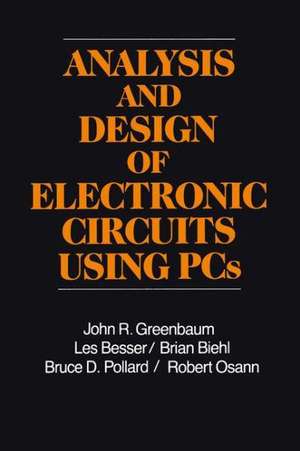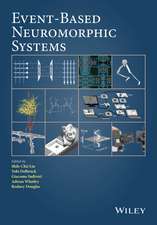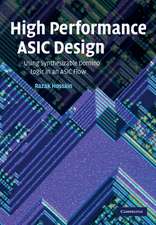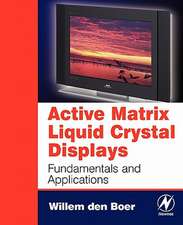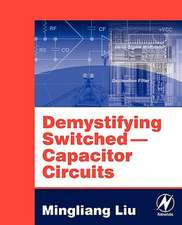Analysis and Design of Electronic Circuits Using PCs
Autor John Greenbaumen Limba Engleză Paperback – 11 mar 2012
Preț: 387.20 lei
Nou
Puncte Express: 581
Preț estimativ în valută:
74.09€ • 79.23$ • 61.78£
74.09€ • 79.23$ • 61.78£
Carte tipărită la comandă
Livrare economică 18 aprilie-02 mai
Preluare comenzi: 021 569.72.76
Specificații
ISBN-13: 9789401170208
ISBN-10: 9401170207
Pagini: 292
Ilustrații: VIII, 278 p.
Dimensiuni: 152 x 229 x 15 mm
Greutate: 0.4 kg
Ediția:Softcover reprint of the original 1st ed. 1988
Editura: SPRINGER NETHERLANDS
Colecția Springer
Locul publicării:Dordrecht, Netherlands
ISBN-10: 9401170207
Pagini: 292
Ilustrații: VIII, 278 p.
Dimensiuni: 152 x 229 x 15 mm
Greutate: 0.4 kg
Ediția:Softcover reprint of the original 1st ed. 1988
Editura: SPRINGER NETHERLANDS
Colecția Springer
Locul publicării:Dordrecht, Netherlands
Public țintă
ResearchCuprins
1. Introduction.- 1.1. The Role of Pcs in Circuit Analysis and Design: An Overview.- 1.2. Desirable Characteristics of Circuit Analysis Programs.- 1.3. From Analysis to Design.- 1.4. Organization of Book.- 2. PC Basics.- 2.1. Introduction.- 2.2. Number Systems, Codes, Bits, Bytes, and Words.- 2.3. Hardware.- 2.4. Software.- 2.5. Special Topics.- 2.6. Conclusion.- 3. Ac, Dc, and Transient Circuit Simulation Programs.- 3.1. Introduction.- 3.2. Three Circuit Simulators for PCs.- 3.3. Architecture of a Circuit Simulator.- 3.4. Modeling.- 4. Computer-Aided Design at Microwave Frequencies.- 4.1. Historical Review.- 4.2. Circuit Analysis.- 4.3. Circuit Synthesis.- 4.4. Transmission Line Analysis and Synthesis.- 4.5. Circuit Optimization.- 4.6. Statistical Analysis.- 4.7. Active Device Modeling.- 4.8. Circuit Contents Layout and Mask Design.- 4.9. Nonlinear Circuit Design.- 4.10. Illustrative Examples.- 4.11. The Future.- 5. Digital Design and Analysis.- 5.1. Introduction.- 5.2. PLDs Proliferate CAE on PCs.- 5.3. PALASM, the First PLD Design Language.- 5.4. CUPL, the First High-level Universal Language for PLDs.- 5.5. ABEL, first High-level PDL Language with State Machine Capability.- 5.6. Arrival of High-level Design on PCs.- 6. The Use of PCS for Industrial/Laboratory Automation.- 6.1. Introduction.- 6.2. Basics.- 6.3. Connecting a Digital pH Meter to a Computer.- 6.4. Serial Interfacing (Asynchronous RS-232C).- 6.5. Analog Signal Acquisition.- 6.6. PC-based Robotic Workstations.- 6.7. Summary and Conclusion.- 7. Special Computer Codes.- 7.1. Introduction.- 7.2. Fitting General-order Polynomials.- 7.3. Designing T- and Pi-Pads.- 7.4. Calculating “L”-Networks.- 7.5. Bandpass Filters.- 7.6. Cad Cuts Math in RF Amplifier Design.- 7.7. Simulating a Servo System.- Appendix AGlossary of Terms.- Appendix B Bias-D Reference Manual.- E-1. Introduction.- E-2. Input Data.- E-3. Miscellaneous.
